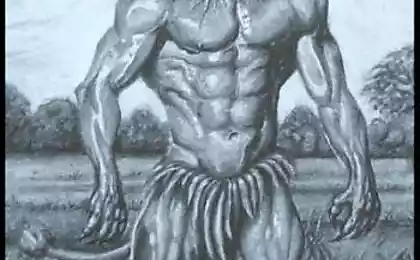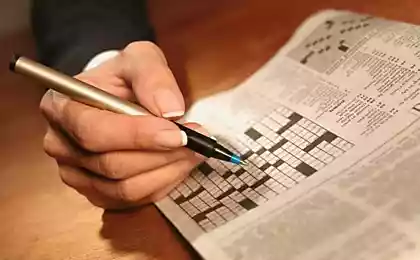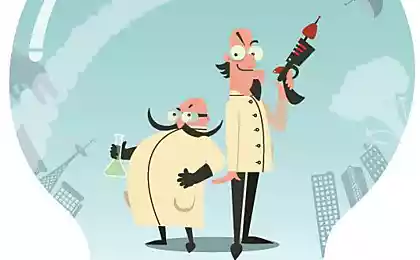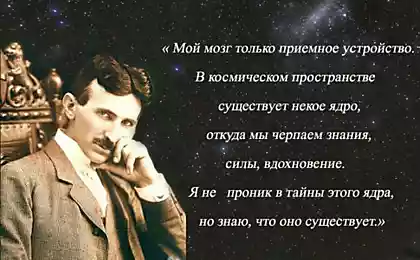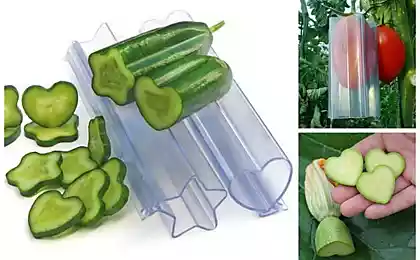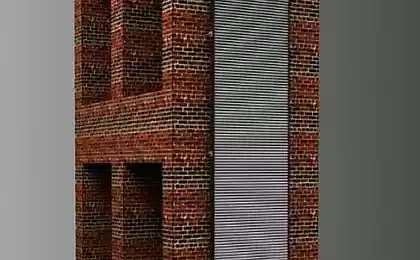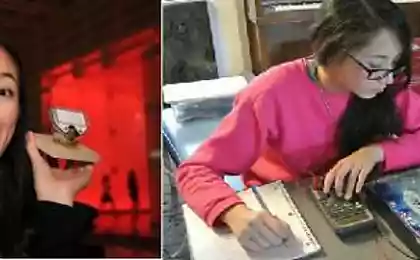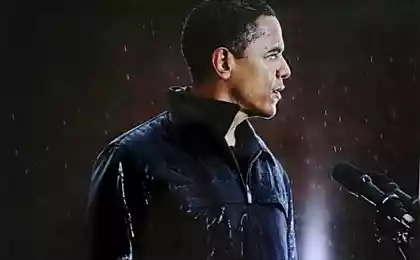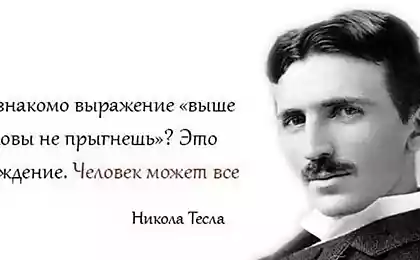1028
The worst invention (11 photos)
These inventions did not bring anything useful to mankind, although some of them still have been applied
ComfortWipe - wipe comfortably
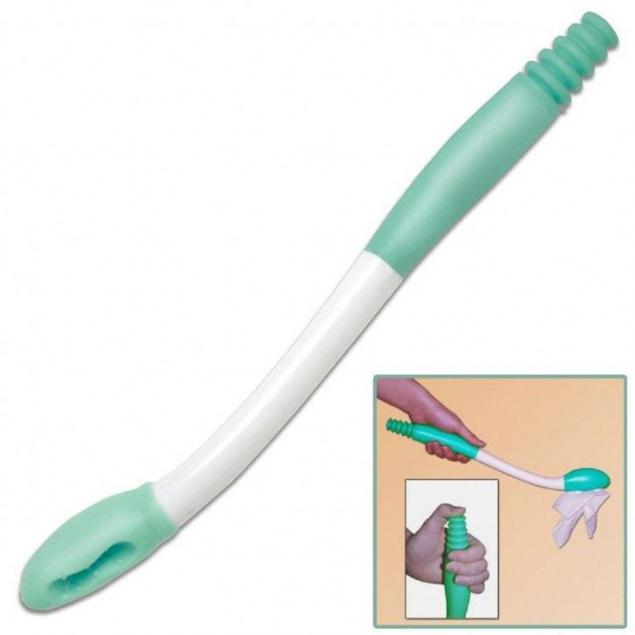
Do you want to prevent accidental contact of hands with your anus, podtirayas after using the toilet? Use ComfortWipe! This device is equipped with a comfortable plastic handle and clip, where you want to paste the toilet paper. After completion of the delicate touch of a button procedure used paper goes in the toilet. The company has developed a product ComfortWipe back in 2009, but sold it never did. If you search well, then the Internet can find several resources where you can purchase a copy of the subject of hygiene. Hair thickener
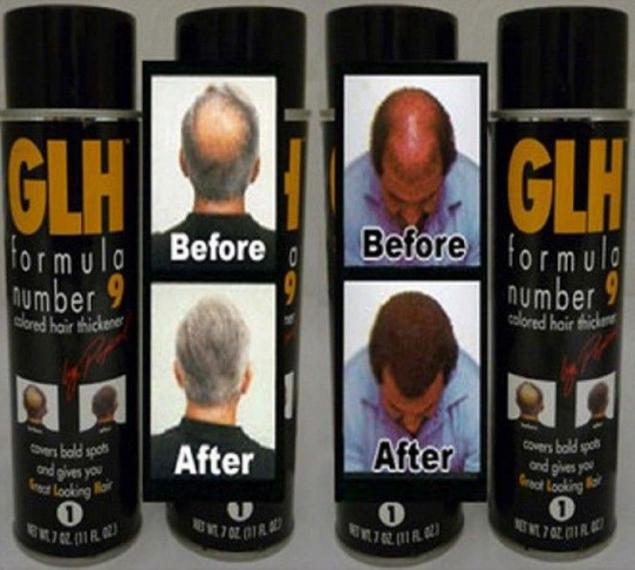
American inventor Ron Popeyl known as the man who invented the shredder products Chop-O-Matic. However, one of the worst creations Popeyla (despite the fact that it is still in demand in the market) is considered GLH-9 - Hair thickener. GLH-9 - short for Great Looking Hair: Formula # 9 (translated to English means "Beautiful hair Formula №9») - was launched on the market in the 90s. the last century. Information commercials about this product then often played on TV in the evening, but now you can see them except on YouTube. GLH-9 is a sticky colored powder that is sprayed from the vial to the hair to disguise the bald spots. Many customers have complained that the GLH-9 "crumbling" as well as stain clothing, linens and scalp.
Crinoline

Originally called stiff crinoline fabric, made of cotton and horsehair. In the mid-1850s. the word has become associated with fashionable accessory at a time in the form of wide skirt thin hoops that to hook under the dress to give a curvaceous silhouette. The diameter of the rings crinoline could reach two meters, because of what the ladies felt terrible inconvenience: they could not pass through the narrow door, out of the carriage, or even sit down properly, not to mention the "Marilyn Monroe effect" in windy conditions.
Technology Smell-O-Vision
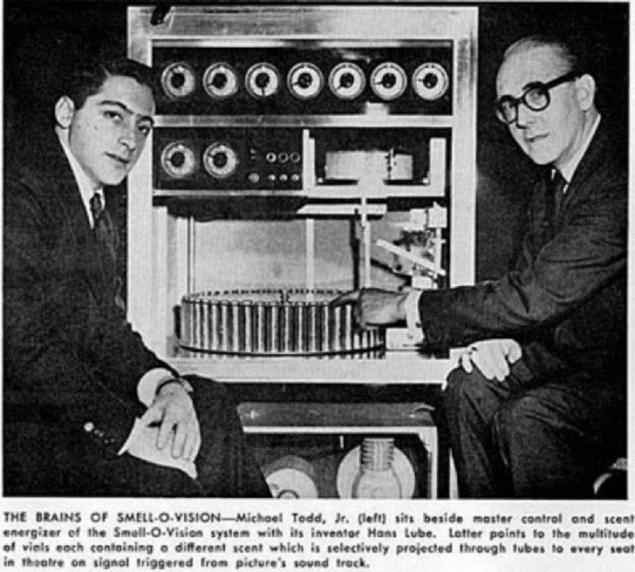
Swiss Hans Laube 50-ies of the XX century. has developed a technology called Smell-O-Vision (translated to English it sounds about as "zapahovidenie"), which allows a deeper plunge into the atmosphere of the film by filling the hall of a cinema different flavors. Scientist demonstrated his invention during display of the painting "The smell of secrets" in 1960. The system Smell-O-Vision by today's standards would have cost $ 8 million, but it had a lot of shortcomings, and therefore did not receive a positive assessment from the audience. Some complained that the presentation of some of the flavors did not coincide with the corresponding sequence in the film, while others claimed that the smell was so weak that I had to take deep breaths to catch them. Now a similar technique is used on some sites and attractions in the World Walt Disney.
Skrepysh
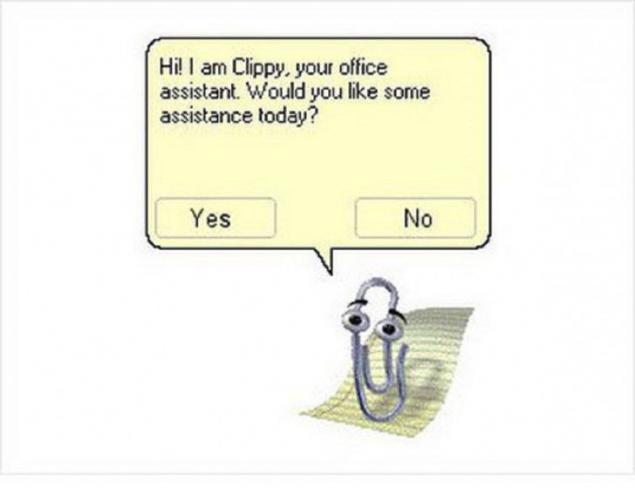
Perhaps this annoying animated character helper familiar to everyone who has ever had to work with older versions of the Office suite of Microsoft Office. Poor Skrepysh appear on the desktop as an uninvited guest at a party: like it is not prevented, but terribly annoyed his insistent desire to help, and statements like "You should be careful with scissors - they are easy to get hurt." Apparently, its creators, like himself, had a set of over-eagerness.
Olestra (Olean) - "low fat" chips

The synthetic fat substitute olestra appeared in the late 1990s., And at the same time it began to be used as an ingredient for the production of "low-fat" chips. Olea distinctive feature is that it has zero calories and is not absorbed when passing through the gastrointestinal tract. And Olestra inhibits the digestibility of essential vitamins and nutrients, and cause cramps and diarrhea, which is why it is banned food additive in Canada and most of Europe. Later Olean found application in the petrochemical industry; Now it is used as a lubricant for machine tools and equipment.
Flying car Mizar

September 11, 1973, Harold Blake, President of Advanced Vehicle Engineers, was killed along with the pilot, whom he had hired to test the flying car based on the Ford Pinto, established with his financial support. The Blake Project invested $ 2 million - a decent sum at the time. But apparently, he was not destined to succeed.
Pay toilets
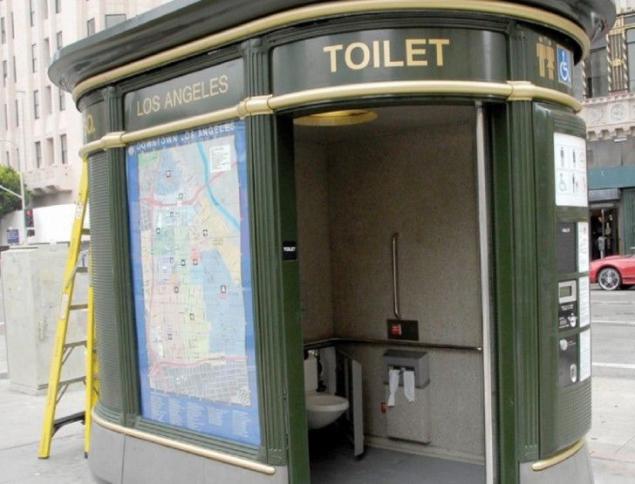
In the early 70-ies. the last century in America, there are tens of thousands of paid toilet stalls receiving only coins. If you were alone in your pocket pyatidesyatidollarovye bills, then you have no other choice but, roughly speaking, to urinate in his pants. In a society where defecate in public places is a crime for which arrest might, many people believed that the pay toilets - it is something from which it was necessary to rid the nation once and for all. In 1970, Ira Jessel created the Committee on the Elimination of paid toilets in the United States. His work has been highly successful, and the first city touched changes became Chicago. By the early 80s. The twentieth century pay toilets have almost disappeared in America. However, in 2001, Midtown (one of the largest boroughs of New York) again were two toll booths toilets with automatic doors: not time to relieve themselves and wear the pants in the allotted time, you - your problems.
Agent Orange
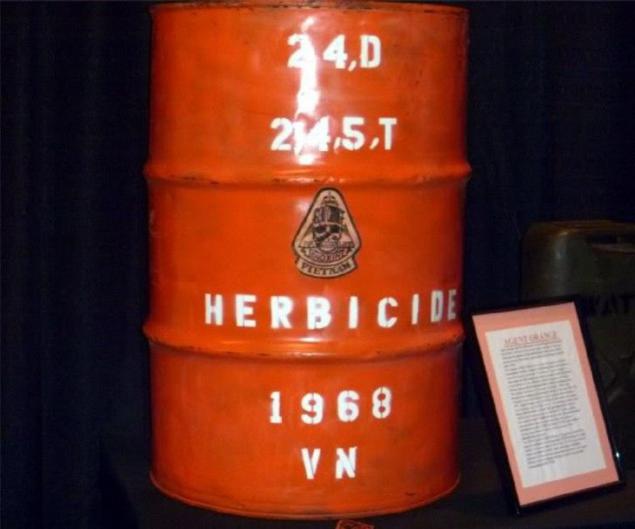
Agent Orange - a mixture of defoliants and herbicides, synthetic origin, which is developed by the Ministry of Defense to destroy the vegetation in South Vietnam and Laos during the Vietnam War. The substance is manufactured by DOW and Monsanto, it was dangerous not only for the trees, but also for people. According to statistics, as a result of the use of killed or maimed hundreds of thousands of Vietnamese civilians. Many veterans of the US Army's return home was diagnosed with cancer, respiratory diseases, nervous system, skin and gastrointestinal tract.
Cage for children
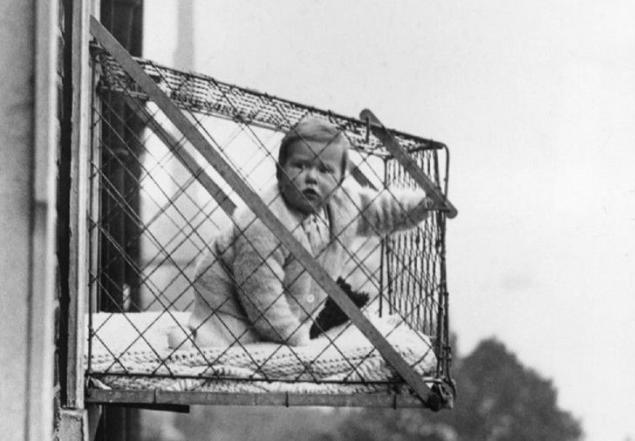
In 1922, a woman named Emma Reid has registered a patent for the invention rather strange - cage for children. It is mounted in the window opening of high-rise residential buildings and planted to a small child. Staying in such cells are replaced kid walk in the fresh air, which, according to the inventor, particularly needy children living in urban environments.
ComfortWipe - wipe comfortably

Do you want to prevent accidental contact of hands with your anus, podtirayas after using the toilet? Use ComfortWipe! This device is equipped with a comfortable plastic handle and clip, where you want to paste the toilet paper. After completion of the delicate touch of a button procedure used paper goes in the toilet. The company has developed a product ComfortWipe back in 2009, but sold it never did. If you search well, then the Internet can find several resources where you can purchase a copy of the subject of hygiene. Hair thickener

American inventor Ron Popeyl known as the man who invented the shredder products Chop-O-Matic. However, one of the worst creations Popeyla (despite the fact that it is still in demand in the market) is considered GLH-9 - Hair thickener. GLH-9 - short for Great Looking Hair: Formula # 9 (translated to English means "Beautiful hair Formula №9») - was launched on the market in the 90s. the last century. Information commercials about this product then often played on TV in the evening, but now you can see them except on YouTube. GLH-9 is a sticky colored powder that is sprayed from the vial to the hair to disguise the bald spots. Many customers have complained that the GLH-9 "crumbling" as well as stain clothing, linens and scalp.
Crinoline

Originally called stiff crinoline fabric, made of cotton and horsehair. In the mid-1850s. the word has become associated with fashionable accessory at a time in the form of wide skirt thin hoops that to hook under the dress to give a curvaceous silhouette. The diameter of the rings crinoline could reach two meters, because of what the ladies felt terrible inconvenience: they could not pass through the narrow door, out of the carriage, or even sit down properly, not to mention the "Marilyn Monroe effect" in windy conditions.
Technology Smell-O-Vision

Swiss Hans Laube 50-ies of the XX century. has developed a technology called Smell-O-Vision (translated to English it sounds about as "zapahovidenie"), which allows a deeper plunge into the atmosphere of the film by filling the hall of a cinema different flavors. Scientist demonstrated his invention during display of the painting "The smell of secrets" in 1960. The system Smell-O-Vision by today's standards would have cost $ 8 million, but it had a lot of shortcomings, and therefore did not receive a positive assessment from the audience. Some complained that the presentation of some of the flavors did not coincide with the corresponding sequence in the film, while others claimed that the smell was so weak that I had to take deep breaths to catch them. Now a similar technique is used on some sites and attractions in the World Walt Disney.
Skrepysh

Perhaps this annoying animated character helper familiar to everyone who has ever had to work with older versions of the Office suite of Microsoft Office. Poor Skrepysh appear on the desktop as an uninvited guest at a party: like it is not prevented, but terribly annoyed his insistent desire to help, and statements like "You should be careful with scissors - they are easy to get hurt." Apparently, its creators, like himself, had a set of over-eagerness.
Olestra (Olean) - "low fat" chips

The synthetic fat substitute olestra appeared in the late 1990s., And at the same time it began to be used as an ingredient for the production of "low-fat" chips. Olea distinctive feature is that it has zero calories and is not absorbed when passing through the gastrointestinal tract. And Olestra inhibits the digestibility of essential vitamins and nutrients, and cause cramps and diarrhea, which is why it is banned food additive in Canada and most of Europe. Later Olean found application in the petrochemical industry; Now it is used as a lubricant for machine tools and equipment.
Flying car Mizar

September 11, 1973, Harold Blake, President of Advanced Vehicle Engineers, was killed along with the pilot, whom he had hired to test the flying car based on the Ford Pinto, established with his financial support. The Blake Project invested $ 2 million - a decent sum at the time. But apparently, he was not destined to succeed.
Pay toilets

In the early 70-ies. the last century in America, there are tens of thousands of paid toilet stalls receiving only coins. If you were alone in your pocket pyatidesyatidollarovye bills, then you have no other choice but, roughly speaking, to urinate in his pants. In a society where defecate in public places is a crime for which arrest might, many people believed that the pay toilets - it is something from which it was necessary to rid the nation once and for all. In 1970, Ira Jessel created the Committee on the Elimination of paid toilets in the United States. His work has been highly successful, and the first city touched changes became Chicago. By the early 80s. The twentieth century pay toilets have almost disappeared in America. However, in 2001, Midtown (one of the largest boroughs of New York) again were two toll booths toilets with automatic doors: not time to relieve themselves and wear the pants in the allotted time, you - your problems.
Agent Orange

Agent Orange - a mixture of defoliants and herbicides, synthetic origin, which is developed by the Ministry of Defense to destroy the vegetation in South Vietnam and Laos during the Vietnam War. The substance is manufactured by DOW and Monsanto, it was dangerous not only for the trees, but also for people. According to statistics, as a result of the use of killed or maimed hundreds of thousands of Vietnamese civilians. Many veterans of the US Army's return home was diagnosed with cancer, respiratory diseases, nervous system, skin and gastrointestinal tract.
Cage for children

In 1922, a woman named Emma Reid has registered a patent for the invention rather strange - cage for children. It is mounted in the window opening of high-rise residential buildings and planted to a small child. Staying in such cells are replaced kid walk in the fresh air, which, according to the inventor, particularly needy children living in urban environments.
Interesting facts about the Disney cartoons (9 photos)
The best drawings of the 20th century (8 photos)
